
Oct 13 , 2020
The Great Pacific Garbage Patch – What we know
It’s twice the size of Texas, it’s floating in the middle of the Pacific Ocean, and you probably helped make it.
We’re talking about the Great Pacific Garbage Patch – or Pacific Trash Vortex – an area of ocean with exceptionally high concentrations of plastic pollution and other inorganic waste. It has been growing in the seas between the north-west United States and the east coast of Japan for about 70 years, fed by ocean currents carrying discarded plastic from all corners of the globe.
It has become a stark reminder of humanity’s impact on our planet and has come to symbolise the extent of the plastic pollution epidemic. And rightly so… The scale of the patch cannot be overstated.

In numbers
There are ten times more pieces of plastic floating in this part of the ocean than there are stars in the Milky Way. That’s around 1.8 trillion individual pieces totalling around 80,000 tonnes of plastic. More than 90% of it is over 0.5cm in length, and half of it is made from discarded commercial fishing gear. Over time, the plastic breaks down to microscopic particles which gradually poison the food chain from the bottom up, while larger pieces are directly ingested by marine life and end up choking endangered seabirds like the albatross. Meanwhile, turtles are often entangled in discarded netting, eventually dragged down and drowned.
Despite the images often circulated on the internet, the patch itself doesn’t resemble a floating island of impenetrable garbage. In fact, on the surface the issue isn’t immediately obvious as most of the waste is suspended in the water column at a relatively low density – around four plastic particles per cubic metre of ocean. That’s why it has proven difficult for scientists to track the patch from the air or via satellite and reach an accurate measurement for its size. But one thing they are agreed on is that it is only going to get bigger.

Fighting the problem
The situation might sound desperate and the effect on wildlife is undoubtedly catastrophic, but all is not lost. Thankfully there are some clever people out their looking to tackle the problem head on.
One team of scientists is willing to undertake the mammoth task of cleaning up the patch itself, skimming larger pieces of plastic from the surface of the water with a giant floating device.
The brainchild of Dutch teenager Boyan Slat, the Ocean Cleanup Project is looking to tow a specially-made plastic catcher out of San Francisco Bay and onto the open ocean to essentially ‘hoover up’ plastic waste floating on the surface of the water. They aim to halve the size of the patch every five years, eventually clearing it altogether by 2040. The project has received some major backing in recent months including the Dutch government and now has a budget of around 20 million euros. 60 such devices are planned for release which could remove around 8,000 tonnes of plastic from the world’s oceans each year.
Elsewhere, others are hoping to stop rising marine plastic at its source. The city of Kwinana in Western Australia has been praised for its brilliantly simple (and cost effective) solution for removing plastic waste from waterways before it even makes it to the ocean. The local authority made the genius move of attaching giant nets to its two main drainage outlets earlier this year. Since then the nets have stopped nearly 370kg of litter and other pollution from being washed into the sea.
A little closer to home, the City of London has also pledged to cut down the amount of plastic waste washed out to the sea by the river Thames. Once notorious for being one of the most polluted waterways in the world, the historic river has really cleaned up its act in recent decades. However, litter in the Thames is still a big problem and with rising concern for the impact of plastic in the oceans, London authorities were quick to find a solution. A number of government and privately-funded projects have since moored ‘floating bins’ along the banks of the 215-mile-long river to catch any waste before it has a chance to reach the ocean. The ‘Passive Debris Collectors’ – as they have been so eloquently named – have scooped up more than 40 tonnes of waste from the river each year since they were launched in 2010.

What can I do?
Armchair activism has its benefits of course. Signing petitions, writing to your local authorities and simply spreading the word among your followers is certainly a start. But any true change starts at home. Many campaigners are encouraging people to shop smarter and make more informed choices when we are browsing the supermarket shelves. With around half of the Great Pacific Garbage Patch made up of discarded fishing gear, buying sustainable, responsibly-sourced seafood is super important. Don’t support irresponsible suppliers.
Meanwhile, reducing your personal single-use plastic usage and how much you throw away can minimise your individual contribution to the problem. The less you throw out, the less of a chance it has of reaching the sea. Replacing throwaway coffee cups, for example, with a reusable beverage cup or bottle (bioGo sells circular products like this!), disposing of plastic properly, and other minor changes to your lifestyle can have meaningful impact, especially if we all do it.
And finally, why not head to the front line in the battle against plastic waste and get your hands dirty? Organise a litter pick on a nearby beach or take part in a clean-up of your local waterways.
Even just clearing up some rubbish you come across on the beach breaks the chain and stops that plastic from ever reaching the ocean.
